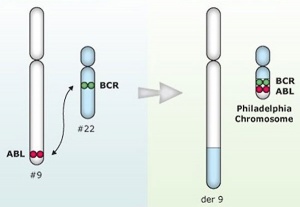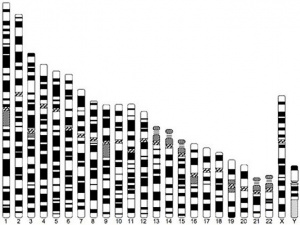Philadelphia chromosome
| Embryology - 30 Apr 2024 |
|---|
| Google Translate - select your language from the list shown below (this will open a new external page) |
|
العربية | català | 中文 | 中國傳統的 | français | Deutsche | עִברִית | हिंदी | bahasa Indonesia | italiano | 日本語 | 한국어 | မြန်မာ | Pilipino | Polskie | português | ਪੰਜਾਬੀ ਦੇ | Română | русский | Español | Swahili | Svensk | ไทย | Türkçe | اردو | ייִדיש | Tiếng Việt These external translations are automated and may not be accurate. (More? About Translations) |
Introduction
The Philadelphia (Ph) chromosome or Philadelphia translocation refers to a chromosomal abnormality resulting from a reciprocal translocation between chromosome 9 and 22. This is described by the genetic molecular shorthand t(9;22)(q34;q11).
The translocation is associated with the disease chronic myelogenous leukemia (CML).
| Cell Division - Meiosis | Cell Division - Mitosis
Some Recent Findings
|
| More recent papers |
|---|
|
This table allows an automated computer search of the external PubMed database using the listed "Search term" text link.
More? References | Discussion Page | Journal Searches | 2019 References | 2020 References Search term: Philadelphia chromosome <pubmed limit=5>Philadelphia chromosome</pubmed> |
History
The following abstract is from a 2007 paper written by one of the original discoverers of this chromosomal abnormality and its association with chronic myelogenous leukemia.[2] This issue of the Journal of Clinical Investigation also devotes a section of papers in a Review Series].
Discovery of the Philadelphia chromosome: a personal perspective
J Clin Invest. 2007 Aug;117(8):2033-5. Nowell PC.
Department of Pathology and Laboratory Medicine, University of Pennsylvania School of Medicine, Philadelphia, Pennsylvania 19104-6082, USA. nowell@mail.med.upenn.edu
- "Almost 50 years ago, David Hungerford and I noticed an abnormally small chromosome in cells from patients with chronic myelogenous leukemia (CML). This article is a personal perspective of the events leading to the discovery of this chromosome, which became known as the Philadelphia chromosome. As technology advanced over subsequent decades, the translocation resulting in the Philadelphia chromosome has been identified, its role in the development of CML has been confirmed, and a therapy directed against the abnormal protein it produces has shown promising results in the treatment of patients with CML."
Chromosome 9 and 12
| |
| Idiogram Chromosome Banding - The term refers to the light and dark pattern, seen after staining with a dye, of individual chromosomes identified in metaphase. It is only in meiosis and mitosis during metaphase that chromosomes can be easily identified, during the normal cell life (interphase) the chromosomes are unravelled and distributed within the nucleus in chromosome territories. A band is that part of a chromosome which is clearly distinguishable from nearby regions by appearing darker or brighter with one or more banding techniques. | |
| Genetic abnormality locations: 1-4 | 5-8 | 9-12 | 13-16 | 17-20 | 21-XY | sSMC | |
| |
| Links: Genetics | Abnormal Development - Genetic |
Cite this page: Hill, M.A. (2024, April 30) Embryology Philadelphia chromosome. Retrieved from https://embryology.med.unsw.edu.au/embryology/index.php/Philadelphia_chromosome
- © Dr Mark Hill 2024, UNSW Embryology ISBN: 978 0 7334 2609 4 - UNSW CRICOS Provider Code No. 00098G
References
- ↑ <pubmed>19737651</pubmed>
- ↑ <pubmed>17671636</pubmed>| PMC1934591 | J Clin Invest.
Reviews
Articles
Search Pubmed
Search Pubmed: Philadelphia chromosome | Philadelphia translocation | chronic myelogenous leukemia
Glossary Links
- Glossary: A | B | C | D | E | F | G | H | I | J | K | L | M | N | O | P | Q | R | S | T | U | V | W | X | Y | Z | Numbers | Symbols | Term Link
Cite this page: Hill, M.A. (2024, April 30) Embryology Philadelphia chromosome. Retrieved from https://embryology.med.unsw.edu.au/embryology/index.php/Philadelphia_chromosome
- © Dr Mark Hill 2024, UNSW Embryology ISBN: 978 0 7334 2609 4 - UNSW CRICOS Provider Code No. 00098G


